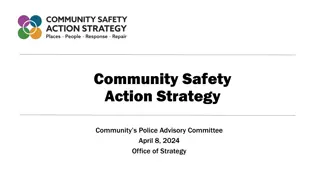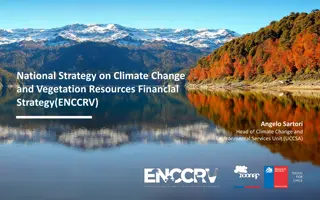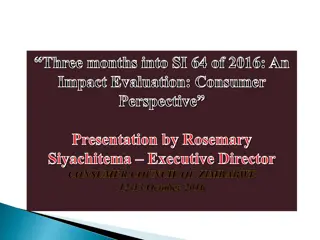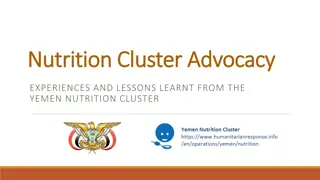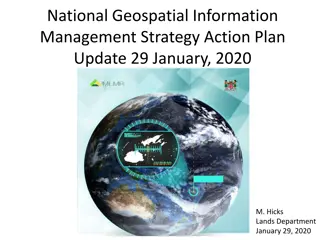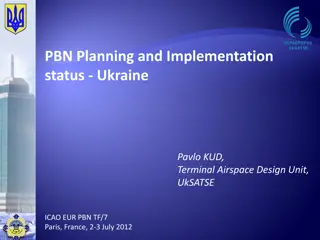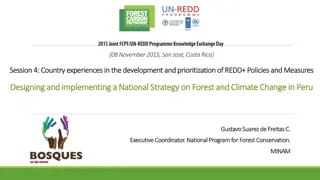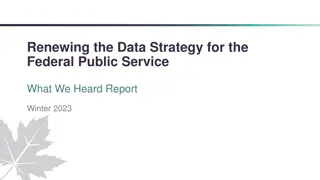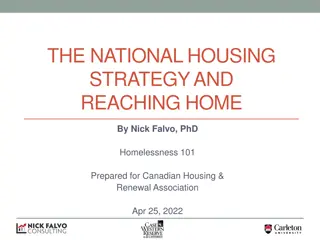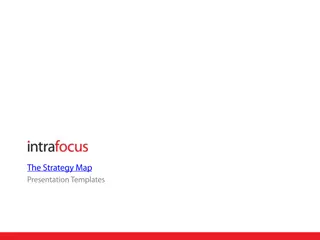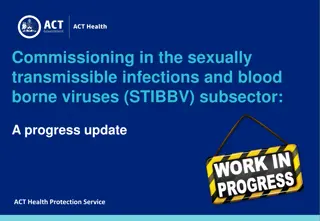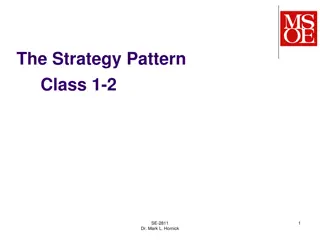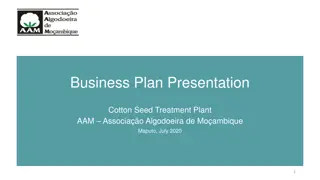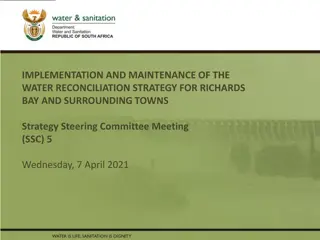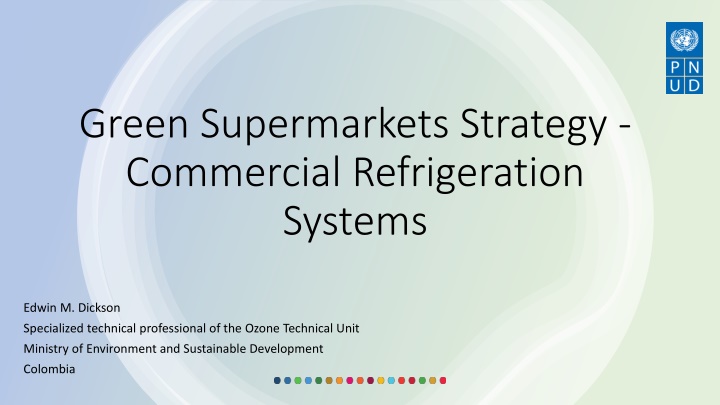
National Strategy for Supermarket Subsector Implementation
This document outlines the Green National Strategy for the implementation of measures and alternatives to enhance energy efficiency and reduce the environmental impact of commercial refrigeration systems in the Colombian supermarket subsector. It details steps like forming working groups, characterizing refrigeration systems, developing reduction scenarios, and exploring financing options.
Download Presentation

Please find below an Image/Link to download the presentation.
The content on the website is provided AS IS for your information and personal use only. It may not be sold, licensed, or shared on other websites without obtaining consent from the author. If you encounter any issues during the download, it is possible that the publisher has removed the file from their server.
You are allowed to download the files provided on this website for personal or commercial use, subject to the condition that they are used lawfully. All files are the property of their respective owners.
The content on the website is provided AS IS for your information and personal use only. It may not be sold, licensed, or shared on other websites without obtaining consent from the author.
E N D
Presentation Transcript
Green Supermarkets Strategy - Commercial Refrigeration Systems Edwin M. Dickson Specialized technical professional of the Ozone Technical Unit Ministry of Environment and Sustainable Development Colombia
Green National strategy for supermarket subsector Green National strategy for supermarket subsector How to built this strategy: How to built this strategy: Green supermarket national strategy: This is a national strategy for the implementation of measures and alternatives that improve energy efficiency and the direct environmental impact of the commercial refrigeration systems and equipment Leader: Ministry of Environment and Sustainable Development - Ozone Technical Unit: If you want to accomplish with the roadmap you should work with these two aspects: Developing demonstrative Project (Pilot). Developing demonstrative Project (Pilot). Define an economic mechanism for Define an economic mechanism for implementing the roadmap for looking implementing the roadmap for looking budget and initiatives that have capability budget and initiatives that have capability for supporting the strategies. for supporting the strategies. of the Colombian supermarket subsector. It was made between 2019 to 2021. 1. First step for making this strategy was to create a working group with this subsector and make a lot of meetings with these actors - Know the barrier - Discernment with working group. Second step is doing the technical characterization of commercial refrigeration systems and make the Business as usual (BAU) scenario about the technologies used by Finally, doing the Roadmap for each kind of stores. Include in the strategy: All related to the education, training of services sector, and technical standard and include the finance alternative that exits in the country for supporting the CAPEX. supermarkets. Third: Define of alternatives for each type of retail. Seeing the availability of these technologies. Strengthening system manufacturers. Fourth: Making the reduction scenarios, what will happen if the supermakets subsector use a definitive alternative?
Document Document - - Green National Strategy for Supermarket Subsector Green National Strategy for Supermarket Subsector 4 5 8 1 3 6 7 2 Measures and Measures and alternatives alternatives financing financing alternatives alternatives Reduction Reduction scenarios scenarios Reference Reference scenarios scenarios Training and Training and education education Roadmap Roadmap Background Background Characterization Characterization Store and equipment projections. Projections of energy consumption for the period 2020-2030. Projections of the equivalent environmental impact and annual emissions. Main indicators of the BAU scenario. Measures and technical alternatives and technologies with better energy efficiency and ultra low of direct environmental impact. For new equipment and systems, for equipment and systems in operation or use and for equipment and systems at the end of their useful life. DER Scenario: Gradual introduction of natural refrigerants that have ultra low GWP values DEREE Scenario: Incorporationof ultra low GWP refrigerants (DER Scenario) and energy efficiency improvements. Sectorial standard of labor competence. Colombian Technical Standards (NTC) Educational offer in universities. Agreements with manufacturers and importers. Research institutes. Potential projects that require high investment. Credit lines for the implementation of energy efficient technologies in refrigeration. Current lines of credit for energy efficiency projects in stores. Tax incentives. Carbon bond market. Strategy instruments Time Actors Montreal Protocol Kigali Amendment COLOMBIAN NDC PROURE 2022 - 2030 Types of equipment and systems. Characterization of equipment and systems. Determination of store type. Estimation of direct environmental impact. Estimation of the indirect environmental impact.
Characterization Characterization of of commercial commercial refrigeration refrigeration systems systems 34 35 334, 6% 192, 3% 30 194, 3% 25 21 20 20 17 535, 10% Hipermercado (H) 15 Supermercado Grande (SG) Supermercado Mediano (SM) 10 Supermercado Peque o (SP) 5 Tienda de Conveniencia (TC) 3 3 3 5 2 1 4422, 78% 0 H SG LS SM MS SP SS TC H CS Type of Store FORMATO Aut nomo (Autocontenidos) Stand - alone Sistemas centralizados Centralized systems Unidad condensadora (uno a uno) Condensing unit (one to one) Type of store or supermarket Hypermarkets Large supermarket Medium supermarkets Small supermarkets Conveniencestore Commercial area More than 5000 square meters From 3001 to 5000 square meters From 1201 to 3.00 square meter De 701 a 1200 square meter De 100 a 700 square meter
Characterization Characterization of of commercial commercial refrigeration refrigeration systems systems Amount of refrigerant (kg) by store type to national level (Installed + average annual consumption) Amount of refrigerant (kg) per store type unit (Installed + average annual consumption) 90,000 80,000 70,000 250 60,000 200 50,000 150 88,467 227 87,098 40,000 100 81,647 84,344 105 50 30,000 99 50,919 0 20,000 70 HM SG 19 10,000 SM SP 0 TC HM SG SM SP TC
Characterization Characterizationof of commercial commercial refrigeration refrigerationsystems systems kWh per unit of store type (Average) kWh by store type to national level (Average) 90 40,000 80 35,000 70 30,000 60 25,000 50 89 20,000 81 40 15,000 37,515 30 64 17,108 10,000 26,047 20 53 19,962 15,158 5,000 10 0 0 HM HM SG 8 SG SM SM SP SP TC TC
An example about BAU An example about BAU - - Reference scenarios Reference scenarios Thousands of ton CO2-eq/year Direct emissions - Disposal Direct emissions - Operation Indirect emissions
Total emissions Total emissions tCO2 tCO2- -eq eq Total emissions in tC02-eq - Total environmental impact of the country's store sector 800,000 601,953 700,000 495,634 600,000 760,054 500,000 t CO2-eq 400,000 300,000 200,000 100,000 731,078 0 2019 2020 2021 2022 2023 2024 2025 2026 2027 2028 2029 2030 Year
An example about technical and economic sheet on the alternatives
An example about An example about reduction reduction scenarios scenarios Thousands of ton CO2-eq/year DER: Direct emissions - Disposal DER: Direct emissions - Operation DER: Indirect emissions BAU: Direct emissions - Disposal BAU: Direct emissions - Operation BAU: Indirect emissions
Training and education Training and education Sectoral Standard of Sectoral Standard of Labor Competence Labor Competence (NSCL) (NSCL) - - Good Practices in Practices in Refrigeration Encourage NSCL certification of technicians or main actors involved in commercial refrigeration systems and equipment Achievement of new sectoral standards for labor competency Strengthen alliances with SENA Encourage responsible consumption through advertising campaigns related to showing the advantages of implementing alternatives and measures that improve energy efficiency and reduce direct environmental impact. Promotion of the refrigerant gas recovery, recycling and regeneration network (R&R&R Network) Good Creation of new Colombian technical standards (NTC), related to the installation, operation, maintenance and dismantling of the new commercial refrigeration systems and equipment. Colombian Colombian Technical Technical Standards Standards (NTC) (NTC) - - Refrigeration Refrigeration Systems Systems Refrigerant Refrigerant recovery, recovery, recycling and recycling and regeneration regeneration network network Responsible Responsible consumption consumption Educational Educational offer in offer in universities universities for the for the refrigeration refrigeration sector sector Institutes or centers aimed at creating entities that articulate, manage and intertwine all the interested parties involved in the refrigeration and air conditioning market in Colombia. Research Research institutes in institutes in refrigeration refrigeration and air and air conditioning conditioning Agreements Agreements with with manufacturers manufacturers and importers and importers Promote the creation of new specializations or technical careers in commercial refrigeration to include the installation, maintenance, and operation of new equipment or systems with ultra low impact (use of new refrigerants with zero or ultra low Global Warming Potential) and better energy efficiency in the plans. The implementation of new systems and equipment must be accompanied by the training of the operators of these new systems, the stores can make joint agreements with these manufacturers or importers
Roadmap general Roadmap general For all type of store For all type of store Expand the use of technologies in commercial refrigeration such as the use of C02 through systems. transcritical and cascade, use of systems with HFO, hydrocarbons and absorption systems, among others. Adaptation and use of a minimum energy efficiency standard (MEPS) for heating systems centralized refrigeration. Massify the use of control systems and automation of refrigeration equipment. Use of systems and equipment with ultra low GWP refrigerants. Use of stand alone for commercial refrigeration with R290 or HFO. Final disposal of equipment and systems. Removal, reuse or disposal of refrigerant gases. Use of systems and equipment with low GWP refrigerants. Widespread use of cabinet doors for commercial refrigeration systems. Use of low GWP refrigerants (refrigerants with GWP less than 150) Incorporate preventive and predictive maintenance protocols in existing refrigeration systems. Generate protocols for the control of leaks for centralized refrigeration systems. Develop pilot projects for the use of new technologies in commercial refrigeration such as the use of C02 through transcritical and cascade systems . Use of systems with HFO, hydrocarbons and absorption systems, among others. Development of pilot chiller systems with R290 Measures and alternatives that improve energy efficiency and the direct environmental impact Expand training programs for service technicians national level. Agreements with international manufacturing companies for providing training to the service sector. Strengthen personal operation and maintenance capabilities in the new operation and maintenance trends in commercial refrigeration equipment. NTC - technical standards. New job skills - Commercial refrigeration technicians - New technologies. Strengthen alliances with SENA and other training institutions to improve NSCL certification. Promotion of specialization programs in refrigeration areas. Eco-Labelled. Responsible consumption Culture. Career Establishment - Refrigeration Engineering Strategy Training and education Policy regulatory instruments Energy efficiency regulation - Implementation of the Montreal Protocol and the Kigali Amendment - Country commitments for the reduction of greenhouse gases (GHGs) Promotion of lines of credit for the implementation of energy efficiency technologies in refrigeration. Apply tax incentives. Promotion of carbon certificates for the voluntary or regulated market. Apply tax incentives. Promotion of credit lines for the implementation of energy efficiency technologies in refrigeration systems and Apply tax incentives. Economic and market instruments 2025 Medium term 2022 - Short term 2028 Long term Year
Total Total emissions emissions Implementing Implementing the the roadmap roadmap Thousands of ton CO2-eq/year 50 % The achievement of these scenarios depends on the intensity and penetration of the implementation of the measures or alternatives in new equipment or systems, in operation and final disposal.
Conclusion Conclusion This strategy and the step for its construction will be replicated for the rest of the actors in the food cold chain. At the moment: National strategy for the implementation of measures and alternatives that improve energy efficiency and the direct environmental impact of the commercial refrigeration systems and the commercial refrigeration systems and equipment equipment of the Colombian supermarket subsector. Harvesting or production Precooling and/or processing Distribution centres Retails Building process: National strategy for the implementation of measures and alternatives that improve energy efficiency and the direct environmental impact of the air conditioning systems supermarket subsector. systems of the Colombian Next: National strategy for the implementation of measures and alternatives that improve energy efficiency and the direct environmental impact of the refrigeration systems refrigeration systems of the Colombian Food subsector. Refrigeratedtransport Food Distribution Making a demonstrative project is a solution for supporting all the work that have been developed for implementing the green strategy in this subsector, specifically when it tries to implement a new technologies according to the cycle of life of refrigeration systems. Five (5) Stand alone with R290. Lenght: 2,5 meter. New design. Manufactured in Colombia. Three (3) Mini- Chiller with R290 + Glicol. Lenght: 10 meter. New design. Manufactured in Colombia. Finally, these strategies aim to achieve a net-zero food cold chain. Green Cooling Summit 2022, Sep 13-14
Contact Contact Edwin M. Dickson Specialized technical professional of the Ozone Technical Unit - Ministry of Environment and Sustainable Development. Colombia edickson@minambiente.gov.co edwin.dickson@undp.org

